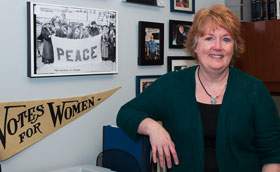- About Ramapo
- Academics
- Admissions & Aid
- Student Life
- Athletics
- Alumni
- Arts & Community
- Quick Links
- Apply
- Visit
- Give
Instructional Design Center
Faculty Profile — Cathy Moran Hajo

When you enter Professor Cathy Moran Hajo’s office in A-wing, you enter the heart of the Jane Addams Papers Project at Ramapo. She is surrounded by a team of history students who analyze, transcribe, and digitize both typed and handwritten correspondence to and from Jane Addams, notable figure of the Progressive movement and advocate for social justice. This project is one example of how Professor Hajo involves students in historical research through technological tools.
Professor Hajo believes it is important for her students to leave college with expertise in a variety of technologies in order to research, investigate, and analyze information and data. This connection to technology has always been a constant in her approach to teaching and scholarship. Even though the tools have changed over time and will continue to change, she believes it is important for college professors to stay current.
WordPress is one of the main technologies that Professor Hajo employs with her students. The students use WordPress to create websites of their historical research, enabling the students to reach a local and global community with their findings. She also uses Omeka, the platform that powers the Jane Addams Papers, to help students analyze documents and exhibit their findings with an online community of historians. She uses HistoryPin, mapping software that enables students to tag points on a map with historical facts and data. Basecamp is yet another technology employed by Professor Hajo; this project management tool helps students take ownership of their work in group projects.
Professor Hajo has a number of fascinating projects in the works. Notably, she received a COPLAC grant to deliver an online, team-taught course on the subject of censorship. This spring she will partner with Professor Rebecca Dierking at Truman State University to lead online synchronous class sessions with students. The students will conduct independent research on local issues related to censorship and produce WordPress sites highlighting what they discovered.
Recognizing a range of technological expertise among faculty, Professor Hajo has some sage advice: “Don’t be afraid to try a new technology in class by asking your students to discover the tool along with you. This can be a great experience for students and faculty alike.” She also advises taking advantage of the many professional development opportunities available. For the humanities in particular, Professor Hajo recommends the Digital Humanities Summer Institute. This is one resource that has helped Professor Hajo hone her wide range of skills with bringing technology into the classroom.
Categories: Uncategorized
Copyright ©2025 Ramapo College Of New Jersey. Statements And Policies. Contact Webmaster.
